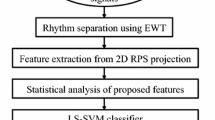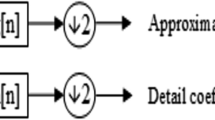Abstract
Feature extraction of partial discharge signal is a key step in pattern recognition and fault diagnosis of insulation defects in power equipment. The singular-spectrum entropy (SSE) theory can study the complexity and irregularity of partial discharge signals but cannot fully reflect the inherent nonlinear characteristics of signals. On this basis, the covariance matrix of SSE is replaced by the Hankel matrix of partial discharge signals, and the local mean decomposition (LMD) theory is introduced to realize the multi-scale method. Then, a multi-scale Hankel singular spectrum entropy (MULTI-HSSE) method for partial discharge signals is proposed. Through the analysis of the simulated partial discharge signals, the entropy eigenvectors extracted by this method can effectively improve the noise suppression ability and enhance the robustness of phase space reconstruction parameters. Finally, three typical partial discharge defects are designed in an outdoor substation environment. The UHF signal entropy eigenvectors using this method are achieved and the RBF neural network is used to classify the defects. Through the experiments, the high recognition accuracy is verified, showing the validity and applicability of the proposed method.
Access this article
We’re sorry, something doesn't seem to be working properly.
Please try refreshing the page. If that doesn't work, please contact support so we can address the problem.






Similar content being viewed by others
References
Y. Xu, W.D. Liu, W.J. Chen, J.G. Yang, K. Zhao, Y. Liu, Partial discharge characteristics of metal particles on spacer surface in GIS based on high sensitivity measurement. High Volt. Eng. 45(9), 2707–2714 (2019). https://doi.org/10.13336/j.1003-6520.hve.20190831003
H. Guo, F.F. Lü, K.F. Ren, Simulation and measurement of PD-induced electromagnetic wave leakage in GIS with metal. IEEE Trans. Dielectr. Electr. Insul. 21(4), 1942–1949 (2014). https://doi.org/10.1109/TDEI.2014.004390
D. Wang, A.J. Ma, Y. Gui, C. Zhang, B. Wang, Q.S. Zhang, Diagnosis of partial discharge insulation fault fusion based on P-CNN. High Volt. Eng. 46(8), 2897–2905 (2020). https://doi.org/10.13336/j.1003-6520.hve.20190118
L.W. Wang, Z.Q. Zhou, L. Lin, J.J. Han, Review on artificial intelligence in substation operation and maintenance management. High Volt. Eng. 46(1), 1–13 (2020). https://doi.org/10.13336/j.1003-6520.hve.20191227001
Y. Wang, J. Yan, Z. Yang, Y. Zhao, T. Liu, GIS partial discharge pattern recognition via lightweight convolutional neural network in the ubiquitous power internet of things context. IET Sci. Meas. Technol. 14(8), 864–871 (2020). https://doi.org/10.1049/iet-smt.2019.0542
H. Ji, X. Lei, Q. Xu, C. Huang, T. Ye, S. Yuan, Research on characteristics of acoustic signal of typical partial discharge models. Glob. Energy Interconnect. 5(1), 118–130 (2022). https://doi.org/10.1016/j.gloei.2022.04.010
W. Sun, Z. Li, S. Cheng, A real time on-line method for automatic signal feature recognition of fault discharge in generator and its application. Power Syst. Technol. 39(2), 543–549 (2015). https://doi.org/10.13335/j.1000-3673.pst.2015.02.038
V. Samaitis, L. Mažeika, A. Jankauskas, R. Rekuvienė, Detection and localization of partial discharge in connectors of air power lines by means of ultrasonic measurements and artificial intelligence models. Sensors 21(1), 20 (2020). https://doi.org/10.3390/s21010020
R. Rostaminia, M. Saniei, M. Vakilian, S.S. Mortazavi, V. Parvin Darabad, An efficient partial discharge pattern recognition method using texture analysis for transformer defect models. Int. Trans. Electr. Energy Syst. 28(7), e2558 (2018). https://doi.org/10.1002/etep.2558
K. Wang, R. Liao, L. Yang, J. Li, S. Grzybowski, J. Hao, Optimal features selected by NSGA-II for partial discharge pulses separation based on time frequency representation and matrix decomposition. IEEE Trans. Dielectr. Electr. Insul. 20(3), 825–836 (2013). https://doi.org/10.1109/TDEI.2013.6518952
R. Rostaminia, M. Saniei, M. Vakilian, S.S. Mortazavi, Evaluation of transformer core contribution to partial discharge electromagnetic waves propagation. Int. J. Electr. Power Energy Syst. 83, 40–48 (2016). https://doi.org/10.1016/j.ijepes.2016.03.054
H. Uehara, T. Okamoto, Modeling and analysis of partial discharge phenomena using integral equations. IEEE Trans. Dielectr. Electr. Insul. 27(6), 1915–1923 (2020). https://doi.org/10.1109/TDEI.2020.009075
F. Yang, G. Sheng, Y. Xu, Y. Qian, X. Jiang, Application of EEMD and high-order singular spectral entropy to feature extraction of partial discharge signals. IEEJ Trans. Electr. Electron. Eng. 13(7), 1002–1010 (2018). https://doi.org/10.1002/tee.22657
X. Luo, H.Q. Niu, T.H. Song, X.L. Zhuang, S transform and probabilistic neural network based partial discharge feature extraction and discharge recognition method. South. Power Syst. Technol. 14(7), 17–23 (2020). https://doi.org/10.13648/j.cnki.issn1674-0629.2020.07.003
F.C. Lv, H. Jin, Z.J. Wang, B. Zhang, GIS partial discharge pattern recognition based on principal component analysis and multiclass relevance vector machine. Trans. China Electrotech. Soc. 30(6), 225–231 (2015). https://doi.org/10.19595/j.cnki.1000-6753.tces.2015.06.028
Q.Q. Zhang, H. Song, Y. Jiang, Y.F. Chen, G.H. Sheng, X.C. Jiang, Partial discharge pattern recognition of transformer based on OS-ELM. High Volt. Eng. 44(4), 1122–1130 (2018). https://doi.org/10.13336/j.1003-6520.hve.20180329011
M.H. Wang, S.D. Lu, M.L. Huang, H.W. Sian, C.C. Hsieh, S.E. Wei, Hybrid methodology based on extension theory for partial discharge fault diagnosis of power capacitors. IEICE Electron. Express 17(18), 20200250 (2020). https://doi.org/10.1587/elex.17.20200250
J.Y. Koo, S.Y. Jung, C.H. Ryu, S.W. Lee, B.W. Lee, Identification of insulation defects in gas-insulated switchgear by chaotic analysis of partial discharge. IET Sci. Meas. Technol. 4(3), 115–124 (2010). https://doi.org/10.1049/iet-smt.2009.0028
J. Dai, Y. Teng, Z. Zhang, Z. Yu, G. Sheng, X. Jiang, Partial discharge data matching method for GIS case-based reasoning. Energies 12(19), 3677 (2019). https://doi.org/10.3390/en12193677
C. Barile, C. Casavola, G. Pappalettera, V. Paramsamy Kannan, Acoustic emission waveforms for damage monitoring in composite materials: shifting in spectral density, entropy and wavelet packet transform. Struct. Health Monit. 21(4), 1768–1789 (2022). https://doi.org/10.1177/14759217211044692
Y. Li, X. Wang, Z. Liu, X. Liang, S. Si, The entropy algorithm and its variants in the fault diagnosis of rotating machinery: a review. IEEE Access 6, 66723–66741 (2018). https://doi.org/10.1109/ACCESS.2018.2873782
C.P. Gandhi, A. Kumar, G. Vashist, H. Tang, A. Rai, J. Xiang, Maximal overlap discrete wavelet packet transforms and variants of neutrosophic cubic cross-entropy-based identification of rotor defects. Meas. Sci. Technol. 33(8), 085107 (2022). https://doi.org/10.1088/1361-6501/ac6001
H.B. Xie, Y.P. Zheng, J.Y. Guo, Classification of the mechanomyogram signal using a wavelet packet transform and singular value decomposition for multifunction prosthesis control. Physiol. Meas. 30(5), 441 (2009)
J. Tang, Y.L. Dong, L. Fan, L.P. Li, Feature information extraction of partial discharge signal with complex wavelet transform and singular value decomposition based on Hankel matrix. Proc. CSEE 35(7), 1808–1817 (2015). https://doi.org/10.13334/j.0258-8013.pcsee.2015.07.031
P. Gupta, B. Singh, Ensembled local mean decomposition and genetic algorithm approach to investigate tool chatter features at higher metal removal rate. J. Vib. Control 28(1–2), 30–44 (2022). https://doi.org/10.1177/1077546320971157
Y. Li, S. Si, Z. Liu, X. Liang, Review of local mean decomposition and its application in fault diagnosis of rotating machinery. J. Syst. Eng. Electron. 30(4), 799–814 (2019). https://doi.org/10.21629/JSEE.2019.04.17
W.T. Silva, F.D. Borges, Genetic algorithms to determine the optimal parameters of an ensemble local mean decomposition. Acta Polytechnica 61(3) (2021). http://hdl.handle.net/10467/98353
P.P. Pagano, E.J. Ciaccio, H. Garan, Separation of cardiogenic oscillations from airflow waveforms using singular spectrum analysis. Comput. Methods Programs Biomed. 220, 106803 (2022). https://doi.org/10.1016/j.cmpb.2022.106803
Y. Yang, C. Li, Discharge current filtering of high voltage pulse power supply based on singular value decomposition of Toeplitz Matrix, in 2021 40th Chinese Control Conference (CCC), Shanghai, China, IEEE, pp. 2935–2939 (2021). https://doi.org/10.23919/CCC52363.2021.9549578
S. Sun, Y. Sun, G. Xu, L. Zhang, Y. Hu, P. Liu, Partial discharge pattern recognition of transformers based on the gray-level co-occurrence matrix of optimal parameters. IEEE Access 9, 102422–102432 (2021). https://doi.org/10.1109/ACCESS.2021.3096287
J. Zheng, Z. Chen, Q. Wang, H. Qiang, W. Xu, GIS partial discharge pattern recognition based on time-frequency features and improved convolutional neural network. Energies 15(19), 7372–7372 (2022). https://doi.org/10.3390/EN15197372
F. Dai, X. Chen, L.X. Wang, H.Z. Ma, Partial discharge recognition of GIL based on Teager energy spectrum ELM. Electric Drive 52(22), 73–80 (2022). https://doi.org/10.19457/j.1001-2095.dqcd23165
Funding
Not applicable.
Author information
Authors and Affiliations
Corresponding author
Ethics declarations
Conflict of interest
The authors declare that they have no conflict of interest.
Additional information
Publisher's Note
Springer Nature remains neutral with regard to jurisdictional claims in published maps and institutional affiliations.
Rights and permissions
Springer Nature or its licensor (e.g. a society or other partner) holds exclusive rights to this article under a publishing agreement with the author(s) or other rightsholder(s); author self-archiving of the accepted manuscript version of this article is solely governed by the terms of such publishing agreement and applicable law.
About this article
Cite this article
Yang, X., Wang, W., Fang, M. et al. Feature Extraction of Partial Discharge Signal Based on Local Mean Decomposition and Multi-scale Singular Spectrum Entropy. J. Inst. Eng. India Ser. B 105, 265–275 (2024). https://doi.org/10.1007/s40031-023-00981-1
Received:
Accepted:
Published:
Issue Date:
DOI: https://doi.org/10.1007/s40031-023-00981-1




